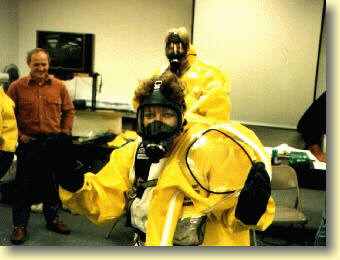|
 Welcome, today we will learn how to don a suit.....
Tired of all this 'new style' suits, go to my Historical
Hazmat Suits page.
The 'Hazmat Suit On Work' page has been redesigned, know
all pictures can been seen in a bigger version by clicking on the small ones.
There are also other manufactures of hazmat suits, but many of these produce the suit
in a kind of plastic, which after my opinion isn't the right material for such garments,
real Hazmat suits have to be made of rubber. |
|
|
| Hood/Respirator |
O
N
H
O
O
D |
 The
mask is place over a thin, elastic rubber-band on the hood edge. The
mask is place over a thin, elastic rubber-band on the hood edge.This type of suits can
be worn with almost any mask on the market. |
|
|
I
N
H
O
O
D |
 The
mask is taken on, and the hood is then placed over the harness and mask edge, and a bands
is tightened, so the mask and the hood is well sealed. Alternative the hood can be fitted
with a elastic rubber-ring. This construction demand that the mask and hood is fitting
well together. The
mask is taken on, and the hood is then placed over the harness and mask edge, and a bands
is tightened, so the mask and the hood is well sealed. Alternative the hood can be fitted
with a elastic rubber-ring. This construction demand that the mask and hood is fitting
well together. |
| Entry
of suit |
Z
I
P
P
E
R |
 A
heavy duty, water and gas proof zipper is the normal closing of a gas tight suit, it
can be placed on the bag, as a shoulder zipper (like Drysuits),
and on the front of the suit. This picture show a front-zipper, this placement makes it
possible for a person to don the suit, without help from others. A
heavy duty, water and gas proof zipper is the normal closing of a gas tight suit, it
can be placed on the bag, as a shoulder zipper (like Drysuits),
and on the front of the suit. This picture show a front-zipper, this placement makes it
possible for a person to don the suit, without help from others. |
| Gloves |
S
E
A
L
E
D |
 Heavy Rubber Gloves is normally used when working with Hazmat. The
gloves is pulled over a Hard-ring placed inside the wrist on the suit. For extra safety
the glove can be secured with a rubber-band or metal ring. Gloves is selected upon the
resistance to the actual chemicals. Heavy Rubber Gloves is normally used when working with Hazmat. The
gloves is pulled over a Hard-ring placed inside the wrist on the suit. For extra safety
the glove can be secured with a rubber-band or metal ring. Gloves is selected upon the
resistance to the actual chemicals. |
|
|
L
O
O
S
E |
 Unsealed gloves is only
used on none gas-proof suits. Unsealed gloves is only
used on none gas-proof suits. |
| Suit
Ventilation |
I
N
L
E
T |
 For
maintaining positive pressure in the suit, in case of a minor leak, a air-inlet is placed
on the suit, and an Air-hose from the SCBA is connected to it. For
maintaining positive pressure in the suit, in case of a minor leak, a air-inlet is placed
on the suit, and an Air-hose from the SCBA is connected to it.In fully-encapsulated
suits the positive pressure is produced by the users expiration. |
|
|
O
U
T
L
E
T |
 The
outlet valve is placed on the highest point on the suit, for Encapsulated suit on the
hood, and for others on the chest. The valve is covered with a splash protection flap. The
outlet valve is placed on the highest point on the suit, for Encapsulated suit on the
hood, and for others on the chest. The valve is covered with a splash protection flap. |
| Boots |
F
I
X
E
D |
 A
heavy, chemical resistant rubber boot is permanently attach to the legs of the suit,
this type of boots is widely used, special on re-useable suits. A
heavy, chemical resistant rubber boot is permanently attach to the legs of the suit,
this type of boots is widely used, special on re-useable suits.Suit are mostly
available with boots in 2 sizes. |
|
|
L
O
O
S
E |
 The
legs on the suit is extended with a pair of socks, made of the suit-material, and from
the knees and of the suit is double. The boots are taken over the socks, and the outer
double leg is pulled out over the boots. This kind of socks is normal used on limited-use
suits, but can also be found on durable rubber suits.. The
legs on the suit is extended with a pair of socks, made of the suit-material, and from
the knees and of the suit is double. The boots are taken over the socks, and the outer
double leg is pulled out over the boots. This kind of socks is normal used on limited-use
suits, but can also be found on durable rubber suits.. |
|



 If a chemical accident is happened on the sea, the hazmat-team is also called
out, dressed in
If a chemical accident is happened on the sea, the hazmat-team is also called
out, dressed in 



 Unsealed gloves is only
used on none gas-proof suits.
Unsealed gloves is only
used on none gas-proof suits.








